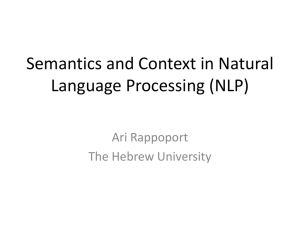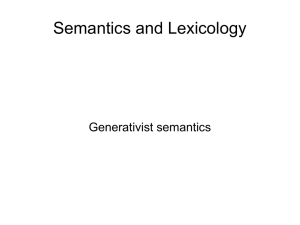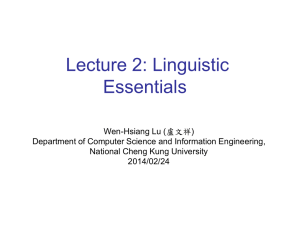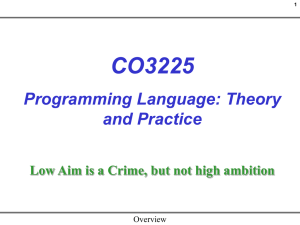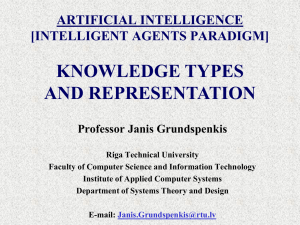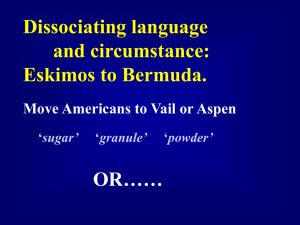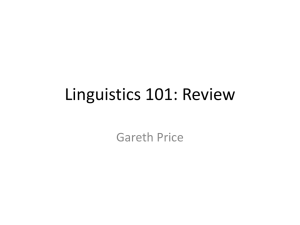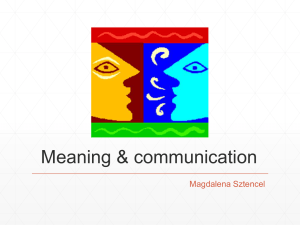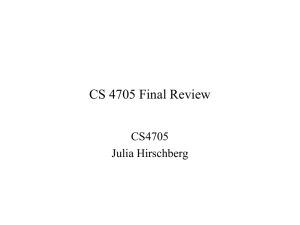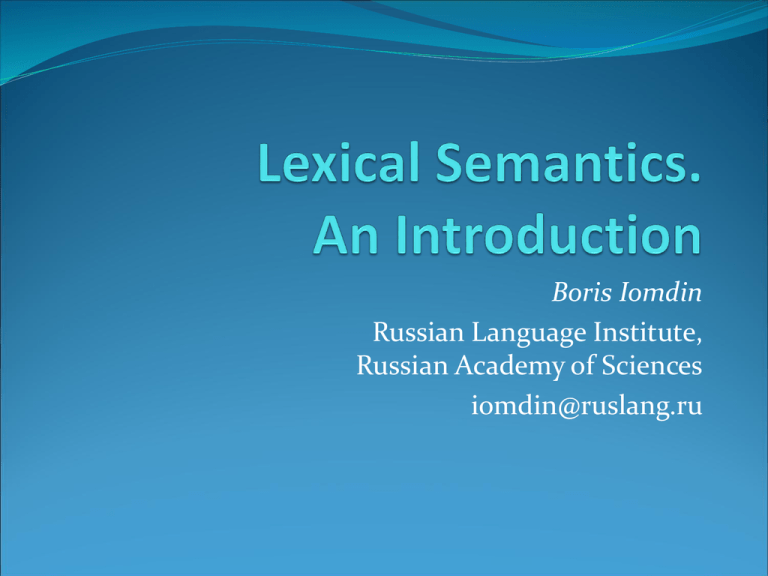
Boris Iomdin
Russian Language Institute,
Russian Academy of Sciences
iomdin@ruslang.ru
Lecture 1. Plan
What is semantics?
History of the term
Semiotics
Types of linguistic signs
Properties of the linguistic sign
Homonymy and synonymy
Semantic triangles
Sense and meaning
Types of meaning
What is semantics?
Semantics is the study of meaning communicated
through language.
The basic task in semantics is to show how people
communicate meanings with their language.
In a broader sense, semantics deals with everything
that the listener has to know in order to understand
what the speaker said.
La sémantique
First occurrence of the term semantics:
M. Bréal, Les lois intellectuelles du langage.
Fragment de sémantique, 1883
< Greek σημαίνω [sēmainō] ‘to signify’
Bréal: semantics studies the “intellectual laws
of language change”. Each language has its own
habits and its own logic, not always consistent
with the logic of reality.
Michel Bréal also invented the marathon race.
Intellectual laws (Bréal)
• Redistribution
• Analogy
• Contamination
• Specialization
• Strengthening
• Weakening
• Metaphor
• Generalization
Die Semasiologie
Ch. C. Reisig, Vorlesungen über lateinische
Sprachwissenschaft, 1839
< Greek: σημασία [sēmasia] ‘signification,
meaning’
Just some short remarks in Reisig’s lectures:
semasiology (or Bedeutungslehre) should be
added to two existing disciplines: syntax and
etymology. It should study relationships
between words and their meanings.
Semantics or Semasiology?
Semantics and semasiology: conflicting synonymical
terms until the 1960-es:
S. Ullmann. The principles of semantics. A linguistic
approach to meaning. 1959.
H. Kronasser. Handbuch der Semasiologie: kurze
Einführung in die Geschichte, Problematik und
Terminologie der Bedeutungslehre. 1952
Since 1960-es: semantics
A.-J. Greimas. Sémantique structural.
Recherche de métode. 1966
W. Frawley. Linguistic semantics. 1992
W. T. Gordon. Semantic: a bibliography. 1965 –
1978; 1978 – 1985.
J. J. Katz. Semantic theory. 1972
G. N. Leech. Semantics. 1974.
J. Lyons. Semantics. 2 vols. 1977
F. R. Palmer. Semantics. 1981
Important recent handbooks
J. R. Hurford, B. Heasley. Semantics: a coursebook. 1983
Semantik: ein internationales Handbuch der
zeitgenössischen Forschung. 1991
T. R. Hoffmann. Realms of meaning: an
introduction to semantics. 1993.
J. Lyons. Linguistic semantics: an introduction.
1995
J. I. Saced. Semantics. 1997
Three uses of the term Semantics
Linguistic semantics: scientific study of all kinds of
linguistic meaning, including grammatical meaning,
but first of all lexical.
Logical semantics: analyzing only the expressions
and their designata (Morris, Carnap and others)
General semantics: a technique for correcting
“certain abuses of language“ (Korzybski). Widely
criticized.
Semiotics
Still earlier, Greek σημα gave birth to another
term: semiotics, proposed by Charles Peirce
(1839-1914).
Pierce studied mathematical logic, philosophy,
and chemistry. In the 1860s he began writing
on semiotic and defined what a sign is.
Bertrand Russell: Pierce was “one of the most
original minds of the later nineteenth century,
and certainly the greatest American thinker
ever.”
Is this a sign?
Sign (Pierce)
“Nothing is a sign unless it is interpreted as a sign”.
If S represents some character(s) of object, O, to an
Interpreter, then S is a sign of O and the information
conveyed to the Interpreter is an Interpretant, I, of O.
Semiosis: action, or influence, which is, or involves, a
cooperation of three subjects, such as a sign, its object,
and its interpretant, this tri-relative influence not
being in any way resolvable into actions between pairs.
Ch. Pierce, Logic as Semiotic: The Theory of Signs.
Types of signs
Icons
Indexes
Symbols
Icon
An icon is a sign which would possess the
character which renders it significant, even
though its object had no existence. An icon and
its object are similar in form or structure.
Examples:
A pencil streak representing a geometrical line.
A photograph in the passport representing the
passholder.
A geographical map representing a country.
Index
An index is a sign which would, at once, lose
the character which makes it a sign if its object
were removed, but would not lose that
character if there were no interpretant. The
index might be caused by the object. Examples:
A bullet-hole as sign of a shot
Smoke as sign of fire
Fever as sign of flu
Symbol
A symbol is a sign which would lose the
character which renders it a sign if there were
no interpretant. The link between the sign and
its object is purely conventional. Examples:
Traffic lights
Musical notes
Interaction of spies
Almost all linguistic signs are…
Symbols. The interpreter cannot understand what a
sign means if he does not know the convention.
But also Icons?
Onomatopeia: meow, bow-wow, moo.
However: French ouaf ouaf, English ribbit ribbit, …
And Indexes?
“Shifters”: I, you; here, there; now, then; …
But not only sounds
Visual signs
Tactile signs (contacts)
Olfactory signs (smells)
Gustatory signs (tastes)
Examples?
Systems of signs: examples
Street lamp signals
Money
Musical notation
Genes
Numbering systems
Programming languages
Gestures
Human languages
Language as a sign system
Universal: all kinds of information (or almost) can be
transmitted by means of language
Highly complicated
Natural: each human language developed “by itself”
for thousands of years
Not hereditary: can only be mastered by means of
imitation and/or learned
De Saussure: language and speech
Human language (system of signs that
express ideas) may be divided into 2
components:
Langue (the abstract system of language)
Parole (individual acts of speech using this
system).
De Saussure:
synchrony and diachrony
Synchronic view: the way a language works
in its current state
Diachronic view: the way a language
changes
These views must be distinguished and not
confused. Within any current state of the
language, it does not matter how the things
have been changing before in order to
describe the current system.
Changes arise in speech
De Saussure: Everything which is diachronic in
languages is only so through speech.
German: was – waren > war – waren
Two sides of the linguistic sign
Classic theory by de Saussure:
the signifier (French le signifiant)
the signified (French le signifié)
• The relation between both sides is arbitrary.
• A sign is the basic unit of language (a given
language at a given time).
• Every language is a complete system of
signs.
Two sides of the linguistic sign
Arbitrariness of the linguistic sign
[nam]
‘numb’ (English)
‘to us’ (Russian)
‘took’ (German)
‘year’ or ‘five’ (Vietnamese)
…
Linguistic signs are
Symbols
Sounds
Can be combined into new complex signs
Can produce infinitely long messages
Asymmetric dualism
of the linguistic sign
S. Kartsevski, Du dualisme asymétrique du signe
linguistique, Travaux du Cercle linguistique de Prague
1, 1929
We speak and comprehend only “approximately”,
without even noticing it
Most words have several different meanings, and most
meanings can be expressed by several different words.
Homonymy and synonymy
One signifier, several signifieds: homonymy
English: table, bear, miss, type, lie
Russian: пол (‘floor’ / ‘sex’)
One signified, several signifiers: synonymy
English: speak, talk, utter, say, verbalise, …
Czech: mluvit, řečnit, říct, povědět, hovořit, …
Lexical semantics mostly deals with
synonyms, computational linguistics mostly
deals with homonymy and its resolution.
Semantic triangle
C. K. Ogden & I. A. Richards, The Meaning of Meaning,
1923
Other semantic triangles
G. Stern, Meaning and change of meaning, 1931
S. Ullmann, Semantics. An introduction to the science
of meaning, 1962
J. Lyons, Semantics. 2 vols, 1977
Different understanding of the relation between
meanings, objects and words.
Types of meaning
Conceptual meaning: logical interpretation
Thematic meaning: What is communicated by the
way in which the message is organized in terms of
order and emphasis.
Associative meaning: see below
G. N. Leech, Semantics, 1981
Associative meaning
Connotative meaning: What is communicated by
virtue of what language refers to.
Social meaning: What is communicated of the social
circumstances of language use.
Affective meaning: What is communicated of the
feelings and attitudes of the speaker.
Reflected meaning: What is communicated through
association with another sense of the expression.
Collocative meaning: What is communicated
through association with words which tend to occur in
the environment of another word.
Sense and meaning
Sinn / Bedeutung (German)
jelentoség / értelem (Hungarian)
смысл / значение (Russian)
Czech? Other languages?
Meaning of proper names
A proper name has no meaning?
Does Aristotle mean ‘the writer of De
Anima’?
Does Aristotle was Greek mean ‘The writer
of De Anima was Greek’?
Sinn und Bedeutung
G. Frege, Über Sinn und Bedeutung, 1892
A = A is not the same thing as A = B.
Samuel Clemens is Samuel Clemens
Samuel Clemens is Mark Twain
A = A is trivial, but A = B is interesting.
Samuel Clemens and Mark Twain have the same
reference (Bedeutung), but two different senses (Sinn)
Confusing translations
For Sinn, the terms sense, intension,
connotation, content, and meaning are used.
For Bedeutung, the terms reference,
referent, extension, denotation, nominatum,
designatum, and meaning are used.
Sense without reference?
Non-referring expressions:
the greatest integer
Odysseus
the capital of Czechoslovakia
king of France
B. Russell: The king of France is bald.
Theory of descriptions
B. Russell, On Denoting, 1905
Denoting phrases which do not denote anything: the
current Emperor of Germany.
Phrases which denote one definite object:
the current President of the USA.
Phrases which denote ambiguously:
a linguist giving lectures on lexical semantics.
Next lecture
lexical meaning VS. grammatical meaning


